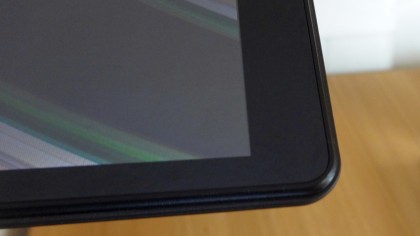Why you can trust TechRadar
Inside the tablet is an Intel Atom processor, the Z3735D, a quad-core model formerly known as Bay Trail-T. Its clock speed ranges from 1.33GHz to 1.83GHz plus it has 224KB L1 cache and 2MB L2 cache.
Since it uses a 22nm process, its maximum TDP is low (sub-4W) which means that it doesn't require a fan to dissipate heat. In other words, it does get warm in use but not hot as it is the case with a lot of other bigger tablets.
What's even more impressive is that it even packs an onboard graphics subsystem, Intel's own HD Graphics. The latter supports DirectX 11 and only packs four execution units, running at up to 646MHz; which makes it powerful enough for the odd game.
It also supports include 64-bit, hardware virtualisation, Quick Sync, AES-NI encryption, Clear Video HD and Wireless Display. Intel deliberately limited memory support to 2GB (single-channel, DDR3L-RS 1333MHz) to avoid any potential competition with more lucrative models (note that the motherboard is a QUMO Vega 8008W).

At 188ppi, the 8-inch IPS display has a higher pixel density than a full HD resolution on a 13.3-inch laptop thanks to a 1,280 x 800 pixel resolution. The display is decent enough for the average user; clear and bright under normal lighting conditions.
The rest of the hardware list includes a 5-point touch capabilities, a speaker, 2GB of RAM, 32GB onboard storage (a Samsung MBG4GC model), 802.11n Wi-Fi, Bluetooth 4.0 and a 18.5Whr (3,700mAh @ 5V) battery.
Once all the necessary Windows updates were applied, about 70% of the available storage space was free. 32GB translates into 32 billion bytes or 29.8 true GBs; Windows showed only 23.5GB out of which 16.2GB are available. The microSD card slot and cloud-based solutions should alleviate the chronic lack of space.
You do also get a 32-bit version of Windows 8.1 with Bing and a one-year subscription to Office 365 personal worth about £48 (about $78, AU$87), that's alone 40% of the tablet's cost.
You should be able to use that subscription on another PC or Mac as well (so 2 devices); all major Office applications (Word, Excel, Powerpoint, OneNote, Outlook, Publisher and even Access) are included. Also bundled are 1TB of online storage plus 12 hours of Skype talk time (one hour a month).
While Windows 8.1 is free, users will need to pony up some dosh if they want to use Microsoft's office suite beyond the first year.

The tablet fared better than I was expecting in actual usage. Booting from cold (i.e pressing on the power on button) to the login page took about 14 seconds, less than my One Plus One smartphone.
PC Mark 8 scores were on par or slightly below our expectations. The Pipo W2 notched 1326 and 827 points respectively in the Work and Creative benchmarks and hit 1019 on the Home one. That's slightly below similar products like the Lenovo Miix 2 or the Toshiba Encore.
We used the PC Mark 8's "home" setting option to measure battery life and decreased display brightness to one notch above dark screen, leaving Wi-Fi on. The benchmark estimated that the W2 would last just over four hours which is slightly below par compared to the rest of the competition.
3DMark figures painted a better picture with the W2 outperforming many Atom-based devices (10929 on Ice Storm and 1015 on Cloud Gate). It couldn't however run Fire Strike and Cinebench 15 - the latter being only available as a 64-bit application.

Désiré has been musing and writing about technology during a career spanning four decades. He dabbled in website builders and web hosting when DHTML and frames were in vogue and started narrating about the impact of technology on society just before the start of the Y2K hysteria at the turn of the last millennium.
